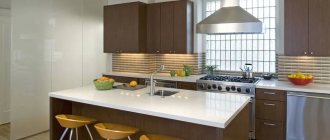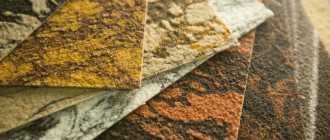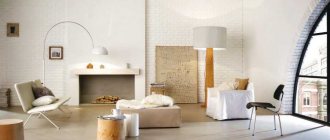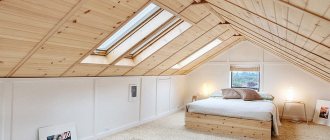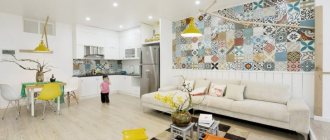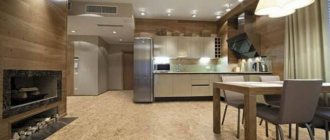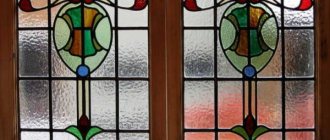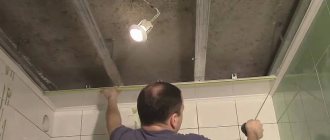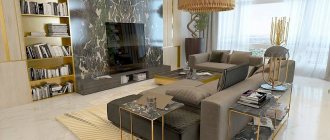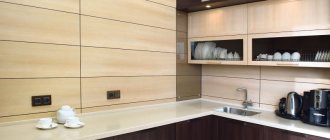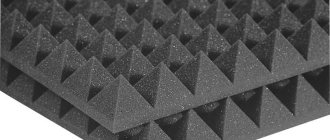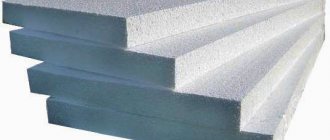Modern designers are increasingly using glass blocks in apartment interiors. This material has good operational characteristics and aesthetic qualities. You can use them to decorate walls or build partitions, decorate doorways, even windows. Your interior will become refined and original.
Glass blocks were used as a building material back in the last century, but having passed through the decades, they have undergone significant changes and returned in a new way to perform decorative functions.
Features of using glass blocks in the interior of an apartment
A block of glass can be different: matte or completely transparent, mirrored, multi-colored. The texture is embossed or smooth, with different effects: dimming the light and scattering it. The color range is wide: from neutral to bright, saturated shades. Externally, it looks like a rectangle hollow from the inside, with walls up to 1 cm thick. The brick is characterized by good sound insulation, but has a cold surface - thermal conductivity is low.
A glass block is two glass half-blocks welded together with a void inside.
Products are available in a variety of designs, you can even find them with stained glass
Classification of glass blocks by external surface
Today you can buy not only colorless transparent glass blocks with a smooth surface, but also decoratively designed options. Depending on the area of application and the planned design, you can select blocks of different colors (from neutral, calm shades to bright, flashy colors) and with different surface finishes (smooth, corrugated or patterned). The method of surface treatment affects the light transmittance of the glass and its transparency.
Glass blocks are classified according to the type of surface treatment:
- even, smooth;
- glossy, with a mirror shine;
- matte;
- embossed.
Depending on the type of surface, the blocks can have a light-scattering or light-directing effect.
Advantages and disadvantages of using glass blocks
Good light transmission qualities can be highlighted - this is one of the favorite materials of modern designers. They do not burden the overall interior; a wide range of colors is provided for interior decoration.
You can decorate an entire wall with glass blocks or diversify the partition with separate colored inserts
Let's look at the main advantages:
- the material is considered universal, suitable for any style: minimalism, high-tech, urban, loft and others;
- practicality in care, just wipe the wall with detergents and wipe dry;
- the product does not burn.
The surface texture of glass blocks can be transparent, scattering or light-directing
We especially note the ease of installation. There are also disadvantages: if you cover the entire wall with it, you need to think through a plan for installing utility lines in advance - it is impossible to install anything through the glass.
Laying in a frame Laying with glue
Laying on mortar
Rules for decorating a room with glass blocks
Previously, this material was used for office premises. It is now popular to use partitions made of glass blocks in an apartment; photos can be viewed on design websites.
Glass block inserts can be used as stylish and expressive accents
There are many design variations even for a small apartment:
- Separating a small hallway from the main corridor or a shower from the bathroom. In such cases, a pallet and a partition made of blocks are simply mounted. High-quality sealing of joints is necessary.
- For the kitchen - studio. The partition is beautifully laid out with multi-colored blocks.
- Installation under the kitchen surface of glass blocks with lighting.
- Decorating a window or doorway using matte or colored blocks.
- Highlighting a wall or partition with corrugated products, with shells or flowers inside, a transparent surface and a glossy sheen.
A stand made of multi-colored glass for an aquarium looks very creative; as an option, a table top with inserts of different textures. This is a durable and practical material, so use your imagination and your home will sparkle with new colors!
Furniture made from glass blocks looks interesting in the interior of the apartment.
You can use glass blocks to make a coffee table or decorate the façade of a kitchen island.
How is glass block different from glass brick?
Both products are made of glass. The main difference is that the first is hollow inside, and the second is solid, that is, completely filled with glass. This type of brick is also called solid brick. Falcone glass blocks and foreign-made Vetropieno glass bricks are known on the Russian market. Italian manufacturers are leaders in the market for glass blocks and glass bricks, offering many interesting solutions.
Modern glass blocks are also produced under the Falcone brand and at some domestic enterprises. Depending on the design, Soviet and Euro glass blocks are distinguished.
Advantages and disadvantages
Such materials have many advantages.
- Glass blocks for walls and bricks allow light to pass through, so partitions made from them help to visually increase the space. The light transmittance of glass blocks is 50-75% of light, transparent - up to 80%.
- High decorative qualities allow you to create unique solutions for decorating various rooms.
- Bricks and blocks are made of durable glass, which is highly resistant to pressure and impact.
- These construction and finishing materials do not burn, do not melt, and do not absorb moisture.
- Glass bricks and blocks have good sound-proofing characteristics, thanks to which they can be used to make partitions between rooms, between a room and a kitchen, or a bathroom.
- Walls and partitions made of such materials do not require additional finishing. There is no need to paint or plaster them.
- Laying glass blocks for partitions and shower stalls, as well as other elements, is not difficult. For this, special glue is used.
- The glass in blocks and bricks is thick and difficult to break.
- Glass successfully resists the effects of most aggressive substances.
- A wall made of glass blocks does not burn and can remain in an open flame for an hour without collapsing.
- Glass surfaces are easy to care for; they can be quickly cleaned using conventional detergents, and more often - even without them.
The disadvantages include the fact that such materials are perfect for modern interiors or exteriors of buildings, but they are not easy to fit into classic or archaic design. However, with a creative approach this is also possible.
Varieties
Glass blocks can have different types of texture - smooth, corrugated, matte, colored. The standard shape of a glass block is a rectangle, but there are products in the form of triangles, corners, circles, and hexagons.
Decorative, construction (industrial) and interior glass blocks are produced.
Examples of using glass blocks
Examples of using glass bricks
Luxpheres, as well as examples of unusual glass blocks in shape, filling, and backlighting
Characteristics and properties
The parameters of glass blocks and bricks are different.
- The dimensions of glass bricks, as a rule, are close to the dimensions of ordinary clay bricks. Standard solutions for glass blocks are 24x24, 19x19 cm with a thickness of 75 to 10 centimeters.
- The weight of glass brick is 3500-3700 grams, glass block - 2.4-2.8 kilograms.
- Glass blocks have a high thermal insulation coefficient, due to which condensation does not form on such walls or windows, even if the air temperature in the room reaches +50 degrees, and outside - minus forty.
- The outer surface of a block or brick can be smooth, matte, corrugated, glossy, patterned.
- The thickness of glass in blocks is on average 6-7 millimeters.
Noise insulation
Glass blocks and bricks differ in their soundproofing parameters. The former, due to the presence of empty space inside filled with air, argon or vacuum, retain sound better. Accordingly, if you want to make a partition or wall through which you can hear less noise, you should choose glass building blocks. In terms of their soundproofing characteristics, they are close to ordinary brick.
Manufacturing technology
Glass blocks are made from glass. First, two panels are cast from glass melt, which are then welded together. Air or argon gas is pumped into the free internal space if it is necessary to create a decorative effect. Air is pumped out of the blocks that are used for exterior cladding of buildings: the vacuum increases the thermal insulation and sound insulation characteristics of the products.
Glass bricks are made differently. Glass is boiled and poured into molds in the form of bars with perfectly smooth edges.
To create colored products, the glass mass is first colored in the mass during the cooking process, and then poured into molds. It is possible to obtain a wide variety of shades.
If you add granules, metal powder, and various small objects, for example, shells of sea animals, to the glass melt, you can get an unusual effect.
Are glass blocks suitable for building a house?
The Italian company Santambrogio Milano built a real glass house. Super-strong glass bricks seven millimeters thick were used for the walls. The walls between the rooms are made of it. staircase steps and furniture. The house seems to merge with the surrounding landscape. At the same time, it is warm.
Using glass blocks when decorating walls
High-quality materials are used for wall cladding with glass blocks.
You should not buy analogues made of plastic - they are fragile and will not last long.
The wall can be supplemented with lighting, the surface can be tinted, or left completely transparent. This is the best option for dividing the kitchen from the room in the studios or beautifully decorating the bathroom. If there is little light in the apartment, installing a glass partition would be the right choice. The sun's rays are refracted in the faces of the cube and conduct light into the room.
A glass block partition is an excellent solution for separating a room and at the same time filling the space with additional light.
Glass blocks for delimiting space in the interior of any apartment can be selected in any shape; look at photos for inspiration on design websites. You can beautifully decorate niches and ledges on the surface of the walls, or build a fake fireplace in the hall.
If you want to create a wall to zone a living space, dilute the materials: also use chipboard and drywall.
Each element is selected taking into account the concept of the overall style. To decorate the wall surface, you can place the products pointwise. In the living room it would be appropriate to create a picture or panel from multi-colored bricks.
Transparent, matte or colored - you can choose the most suitable product option to realize your design idea
Glass block partition with frame
You can fasten glass blocks together and make a partition with your own hands using metal or wooden slats. Assembling such a frame is extremely simple, almost like a children's construction set.
First, we install vertical racks, securing them to the floor and ceiling. Fastening is carried out using dowels and screws.
We place the blocks between the racks, lowering them from top to bottom. We fix each block with horizontal planks.
A wooden frame can also perform the functions of a metal “lattice”. For it we will need slats that are long enough to match the height of the partition. The thickness of the slats depends on the desired thickness of the seam.
We select the width of the slats as follows:
- so that they fit between the protruding edges of the glass blocks,
- would be flush with the plane of the partition,
- or advocated for it (see Fig. 1 a; b).
The only thing is that in the first case, the blocks will be fixed by engaging the edges, and in the second, glue must be used to secure them.
We install vertical slats with a step corresponding to the width of the block between the edges, or the width of the external dimensions. We fasten the frame to the floor and ceiling with steel corners and screws.
We fill the gaps of the racks with glass blocks, alternating them with horizontal inserts. We fasten the inserts with screws to the racks, drilling through them and (or) at the corners (see Fig. 1).
We install the blocks by lowering them along the spaces between the vertical slats of the frame from top to bottom.
We insert glass blocks from top to bottom, securing them with transverse inserts.
In the case where the frame is hidden between the edges of the glass block, installation of the last, top row and especially the last locking block can cause difficulties.
I recommend: How to care for wooden garden furniture
To make this possible, the edges of the block on one side will have to be sharpened with a grinder. We will provide additional fixation with transparent silicone sealant. The same sealant will help correct minor flaws during grinding, if any are made.
Sealing joints between blocks, if necessary, is done in the same way as sealing ceramic tile joints.
Partitions made of glass blocks in the interior of an apartment
Partitions made of transparent glass blocks of different colors are widely used in apartments. The main goal is to zone the room and highlight the area.
Glass blocks are used to create lightweight partitions for zoning a room
Thanks to the transparency of the material, the space is perceived more integral
There are many ideas for partitions:
- oval;
- circle;
- trapezoid;
- arch;
- pyramid.
With the help of glass bricks you can implement many original interior design ideas
The optimal width and height are selected, depending on the ceilings. It is ideal to create a clear, limited space: dressing room, hallway, shower stall. This is a good choice for creating a dining area.
If the room is small, glass blocks will fit perfectly into the overall concept - they visually expand the room.
To enclose the bed and sitting area, frosted or multi-colored glass is used.
An example of separating a sleeping area from the rest of the apartment using a partition made of frosted glass blocks
Features of glass block installation
For those who have experience in laying tiles or brick walls, the issue of installing glass blocks will not seem difficult. However, you need to know some subtleties.
Installation of glass blocks can be carried out in two ways: at the joint using a special adhesive solution and on a special frame base (module) in the form of a lattice with cells. The second option is easier to implement, but it is not always possible to find a suitable base.
First way. To begin with, a profile is attached to the floor, along which the first block is laid. Rows should be laid away from the wall. Special crosses are installed between the blocks. Taking into account the large weight of the blocks and the long time of reliable binding of the solution to the surface of the block, installation is carried out in stages, making a time interval between every third row.
For structural strength, metal rods are laid, avoiding contact of the rod with the block using mounting crosses. When the installation is completed, the joints are grouted. Upon completion of all installation work, you can remove the protective film from the blocks.
Second way. A wooden frame or module with cells of the appropriate size can be purchased at a hardware store. Before starting work, the frame must be securely fastened to the floor, ceiling and adjacent wall.
With this module, glass blocks are laid using rubber gaskets, and the blocks can be removed and replaced if necessary. This method is used to create decorative partitions.
Options for using glass blocks with lighting in the interior of an apartment
This is a great option for living rooms, kitchen surfaces and even the bathroom. It's creative, beautiful, and creates comfort. You can add LEDs to the hallway partition - you can turn it on when entering the apartment, which will demonstrate to your guests your sophisticated taste.
Stylish partition with lighting in a small hallway
Glass blocks with lighting in the kitchen interior
Stylistic compatibility of glass blocks with different styles in the interior of an apartment
Transparent cubes will perfectly highlight and complement any style. Goes well with neoclassical and urban styles, art deco, loft, oriental and modern. You should not perform such finishing for Rococo or Baroque, country, Provence, classical design.
Glass blocks in a loft style kitchen
Glass blocks in the interior of a modern kitchen-living room
There are many interesting options for using glass products: focus on your taste and budget, room size and layout. It is important not to forget about the “coldness” of the material - you need to complement it with “warm” textile decor or living plants.
